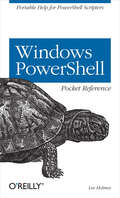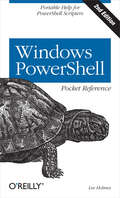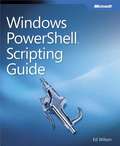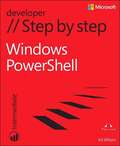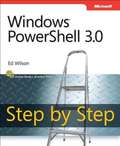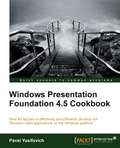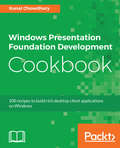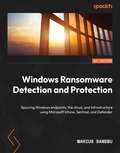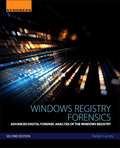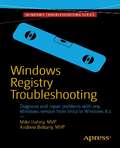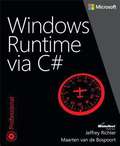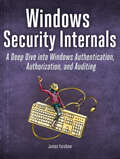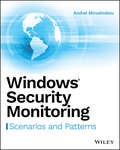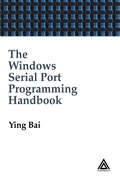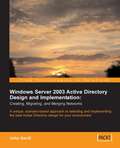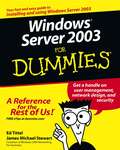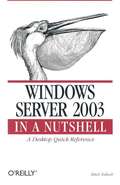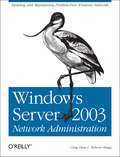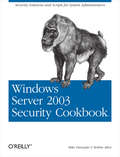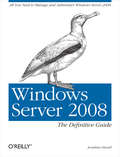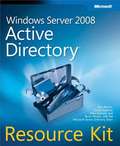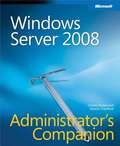- Table View
- List View
Windows PowerShell Pocket Reference
by Lee HolmesThis portable reference to Windows PowerShell summarizes both the command shell and scripting language, and provides a concise reference to the major tasks that make PowerShell so successful. Written by Microsoft PowerShell team member Lee Holmes, and excerpted from his Windows PowerShell Cookbook, Windows PowerShell Pocket Reference offers up-to-date coverage of PowerShell's 1.0 release. It's an ideal on-the-job tool for Windows administrators who don't have time to plow through huge books or search online.
Windows Powershell Pocket Reference (Pocket Reference (O'Reilly))
by Lee HolmesThis portable reference to Windows PowerShell summarizes both the command shell and scripting language, and provides a concise reference to the major tasks that make PowerShell so successful. It's an ideal on-the-job tool for Windows administrators who don't have time to plow through huge books or search online.Written by Microsoft PowerShell team member Lee Holmes, and excerpted from his Windows PowerShell Cookbook, Windows PowerShell Pocket Reference offers up-to-date coverage of PowerShell's 1.0 release. You'll find information on .NET classes and legacy management tools that you need to manage your system, along with chapters on how to write scripts, manage errors, format output, and much more. Beginning with a whirlwind tour of Windows PowerShell, this convenient guide covers: PowerShell language and environmentRegular expression referencePowerShell automatic variablesStandard PowerShell verbsSelected .NET classes and their usesWMI referenceSelected COM objects and their uses.NET string formatting.NET datetime formattingAn authoritative source of information about PowerShell since its earliest betas, Lee Holmes' vast experience lets him incorporate both the "how" and the "why" into the book's discussions. His relationship with the PowerShell and administration community -- through newsgroups, mailing lists, and his informative blog Lee Holmes -- gives him insight into problems faced by administrators and PowerShell users alike.If you're ready to learn this powerful tool without having to break stride in your routine, this is the book you want.
Windows Powershell Pocket Reference: Portable Help for PowerShell Scripters (Pocket Reference (o'reilly) Ser.)
by Lee HolmesThis portable reference to Windows PowerShell summarizes both the command shell and scripting language, and provides a concise reference to the major tasks that make PowerShell so successful. It's an ideal on-the-job tool for Windows administrators who don't have time to plow through huge books or search online. Written by Microsoft PowerShell team member Lee Holmes, and excerpted from his Windows PowerShell Cookbook, Windows PowerShell Pocket Reference offers up-to-date coverage of PowerShell's 1.0 release. You'll find information on .NET classes and legacy management tools that you need to manage your system, along with chapters on how to write scripts, manage errors, format output, and much more. Beginning with a whirlwind tour of Windows PowerShell, this convenient guide covers: PowerShell language and environment Regular expression reference PowerShell automatic variables Standard PowerShell verbs Selected .NET classes and their uses WMI reference Selected COM objects and their uses .NET string formatting .NET datetime formatting An authoritative source of information about PowerShell since its earliest betas, Lee Holmes' vast experience lets him incorporate both the "how" and the "why" into the book's discussions. His relationship with the PowerShell and administration community -- through newsgroups, mailing lists, and his informative blog Lee Holmes -- gives him insight into problems faced by administrators and PowerShell users alike. If you're ready to learn this powerful tool without having to break stride in your routine, this is the book you want.
Windows PowerShell™ Scripting Guide
by Ed WilsonGet practical guidance for using Windows PowerShell to manage Windows Vista and Windows Server 2008. Written by Ed Wilson, a leading scripting expert and trainer at Microsoft, this reference offers a task-based approach to help you find the information you need for day-to-day tasks. With more than 200 scripts, it offers rich examples that administrators can customize for their own environment and needs. The scripts range in complexity from one-line commands, to full-blown scripts with managed output and command-line arguments--examples that are applicable to all skill levels. Includes a companion CD with fully searchable eBook, sample scripts, and other resources for managing your Windows-based environment. A Note Regarding the CD or DVD The print version of this book ships with a CD or DVD. For those customers purchasing one of the digital formats in which this book is available, we are pleased to offer the CD/DVD content as a free download via O'Reilly Media's Digital Distribution services. To download this content, please visit O'Reilly's web site, search for the title of this book to find its catalog page, and click on the link below the cover image (Examples, Companion Content, or Practice Files). Note that while we provide as much of the media content as we are able via free download, we are sometimes limited by licensing restrictions. Please direct any questions or concerns to booktech@oreilly.com.
Windows PowerShell Step by Step, Third Edition
by Ed WilsonYour hands-on guide to Windows PowerShell scripting fundamentals <P><P>Expand your expertise--and teach yourself the fundamentals of Windows PowerShell scripting, including features available in Windows PowerShell 5. If you are an IT professional, power user, or consultant, you’ll get the guidance, exercises, and code you need to master core techniques for automating Windows setup, deployment, and management. <P><P>Discover how to: <ul> <li>Run cmdlets and command-line utilities</li> <li>Administer Windows-based servers and desktops with built-in cmdlets</li> <li>Use providers to access external information</li> <li>Write and run scripts from the Windows ISE</li> <li>Create functions that are easy to maintain</li> <li>Build standardized environments with profiles</li> <li>Automate Windows systems with WMI, CIM cmdlets, and remoting</li> <li>Automate Active Directory Domain Services (AD DS)</li> <li>Debug scripts and handle errors</li> <li>Run commands that survive interruptions</li> <li>Use Desired State Configuration (DSC) to manage software services and their environments</li> <li>Get powerful new modules from PowerShell Gallery</li> </ul> <P><P>About You <br></br> This book is for: <ul> <li>IT professionals and power users who want to get productive with Windows PowerShell, including new features in Windows PowerShell 5</li> <li>Windows system administrators who want to be more efficient and productive</li> <li>Anyone pursuing Windows PowerShell certifications </li> </ul> <P><P>No experience with Windows PowerShell or other scripting technologies necessary
Windows PowerShellTM 3.0 Step by Step
by Ed Wilson<p>Teach yourself the fundamentals of Windows PowerShell 3.0 command line interface and scripting language—one step at a time. Written by a leading scripting expert, this practical tutorial delivers learn-by-doing exercises, timesaving tips, and hands-on sample scripts for performing administrative tasks on both local and remote Windows systems.</p>
Windows Presentation Foundation 4.5 Cookbook
by Pavel YosifovichThis book is written in an easy-to-read style, with a strong emphasis on real-world, practical examples. Step-by-step explanations are provided for performing important tasks. If you are C# developer looking forward to increasing your understanding and knowledge of WPF, then this is the best guide for you. Basic experience with Visual Studio 2010 is mandatory, as well as good C# skills. Previous experience with Windows Forms is not required.
Windows Presentation Foundation Development Cookbook: 100 recipes to build rich desktop client applications on Windows
by Kunal ChowdhuryGain comprehensive insight into WPF mechanics and capabilities. Key Features Gain a strong foundation in WPF features and patterns Leverage the MVVM pattern to build decoupled, maintainable apps Increase efficiency through Performance tuning and UI automation Book Description Windows Presentation Foundation (WPF) is Microsoft's development tool for building rich Windows client user experiences that incorporate UIs, media, and documents. With the updates in .NET 4.7, Visual Studio 2017, C# 7, and .NET Standard 2.0, WPF has taken giant strides and is now easier than ever for developers to use. If you want to get an in-depth view of WPF mechanics and capabilities, then this book is for you. The book begins by teaching you about the fundamentals of WPF and then quickly shows you the standard controls and the layout options. It teaches you about data bindings and how to utilize resources and the MVVM pattern to maintain a clean and reusable structure in your code. After this, you will explore the animation capabilities of WPF and see how they integrate with other mechanisms. Towards the end of the book, you will learn about WCF services and explore WPF's support for debugging and asynchronous operations. By the end of the book, you will have a deep understanding of WPF and will know how to build resilient applications. What you will learn Understand the fundamentals of WPF Explore the major controls and manage element layout Implement data binding Create custom elements that lead to a particular implementation path Customize controls, styles, and templates in XAML Leverage the MVVM pattern to maintain a clean and reusable structure in your code Master practical animations Integrate WCF services in a WPF application Implement WPFs support for debugging and asynchronous operationsWho this book is for The book is intended for developers who are relatively new to WPF (Windows Presentation Foundation), or those who have been working with WPF for some time, but want to get a deeper understanding of its foundation and concepts to gain practical knowledge. Basic knowledge of C# and Visual Studio is assumed.
Windows Ransomware Detection and Protection: Securing Windows endpoints, the cloud, and infrastructure using Microsoft Intune, Sentinel, and Defender
by Marius SandbuProtect your end users and IT infrastructure against common ransomware attack vectors and efficiently monitor future threatsPurchase of the print or Kindle book includes a free PDF eBookKey FeaturesLearn to build security monitoring solutions based on Microsoft 365 and SentinelUnderstand how Zero-Trust access and SASE services can help in mitigating risksBuild a secure foundation for Windows endpoints, email, infrastructure, and cloud servicesBook DescriptionIf you're looking for an effective way to secure your environment against ransomware attacks, this is the book for you. From teaching you how to monitor security threats to establishing countermeasures to protect against ransomware attacks, Windows Ransomware Detection and Protection has it all covered.The book begins by helping you understand how ransomware attacks work, identifying different attack vectors, and showing you how to build a secure network foundation and Windows environment. You'll then explore ransomware countermeasures in different segments, such as Identity and Access Management, networking, Endpoint Manager, cloud, and infrastructure, and learn how to protect against attacks. As you move forward, you'll get to grips with the forensics involved in making important considerations when your system is attacked or compromised with ransomware, the steps you should follow, and how you can monitor the threat landscape for future threats by exploring different online data sources and building processes.By the end of this ransomware book, you'll have learned how configuration settings and scripts can be used to protect Windows from ransomware attacks with 50 tips on security settings to secure your Windows workload.What you will learnUnderstand how ransomware has evolved into a larger threatSecure identity-based access using services like multifactor authenticationEnrich data with threat intelligence and other external data sourcesProtect devices with Microsoft Defender and Network ProtectionFind out how to secure users in Active Directory and Azure Active DirectorySecure your Windows endpoints using Endpoint ManagerDesign network architecture in Azure to reduce the risk of lateral movementWho this book is forThis book is for Windows administrators, cloud administrators, CISOs, and blue team members looking to understand the ransomware problem, how attackers execute intrusions, and how you can use the techniques to counteract attacks. Security administrators who want more insights into how they can secure their environment will also find this book useful. Basic Windows and cloud experience is needed to understand the concepts in this book.
Windows Registry Forensics: Advanced Digital Forensic Analysis Of The Windows Registry (Second Edition)
by Harlan CarveyWindows Registry Forensics: Advanced Digital Forensic Analysis of the Windows Registry, Second Edition, provides the most in-depth guide to forensic investigations involving Windows Registry. This book is one-of-a-kind, giving the background of the Registry to help users develop an understanding of the structure of registry hive files, as well as information stored within keys and values that can have a significant impact on forensic investigations. Tools and techniques for post mortem analysis are discussed at length to take users beyond the current use of viewers and into real analysis of data contained in the Registry. This second edition continues a ground-up approach to understanding so that the treasure trove of the Registry can be mined on a regular and continuing basis.
Windows Registry Troubleshooting
by Mike Halsey Andrew BettanyWhatever version of Windows you're using--from Vista up to Windows 8. 1--the registry is at the heart of your desktop experience. Software installs and compatibility, hardware operation and more are managed by a complex database of codes and numbers. When something goes wrong it can seem impossible to diagnose and repair the problem, and harder still to prevent a recurrence or make the subtle changes and tweaks required to fix the problem. In this book we'll take you inside the workings of the Registry, and teach you how to repair, modify and clean it to keep your PCs running smoothly. What you'll learn 1) How to navigate the architecture of the Windows Registry 2) How to troubleshoot faulty and corrupt Registry items 3) How to edit and work with the Registry files of other users on a PC 4) What tools and utilities can help you work with and repair the Registry 5) How to secure the registry on a Windows PC 6) What Registry tweaks and hacks can make using your Windows PC a better experience Who this book is for Windows power users, system administrators, help desk personnel, people working with Windows in a BYOD environment. Table of Contents Chapter 1: Introducing the Windows Registry Chapter Goal: A deep dive into the structure and architecture of the registry, including its different key types, file structure and hosting. What is the Windows Registry? Windows Registry files The Registry Structure in Depth Registry Keys in Depth Chapter 2: Using Registry Tools in Windows Chapter Goal: Teaching people about the various tools available to help them work with the Registry in any version of Windows Windows Regedit ScanReg Process Monitor CCleaner Additional third-party Registry tools Comparing before and after Registries Chapter 3: Troubleshooting and Corrupt Registry Chapter Goal: Teaching the reader how to diagnose and repair issues with a corrupt registry on a PC Troubleshooting fundamentals Finding corruptions within the Registry Chapter 4: Advanced Registry Troubleshooting Chapter Goal: Teaching people how they can perform advanced diagnostics and troubleshooting including working on other people's Registry files Editing other users' Registry files Advanced diagnosis of the Windows Registry Advanced key repair and replacement Chapter 5: Securing the Windows Registry Chapter Goal: Teaching people how to ensure the registries on their PCs are safe from malware attack and direct interference Understanding Registry security on your PC Securing the Registry with the Windows security tools Securing the Registry with encryption Managing and maintaining strong password enforcement for system administrators Chapter 6: Tweaks, Hacks and Common Registry Changes Chapter Goal: Bonus material to help IT pros harness the full power and potential of the registry for enhancing the user and productivity experience, while also providing examples readers can use to practice Registry editing Common Registry Hacks Tweaking the Registry to improve the PC experience Other common Registry changes and why you would make them
Windows Runtime via C#
by Jeffrey Richter Maarten van de Bospoort<p>Focusing on the non-UI side of Windows app development, this guide delivers a thorough grounding in Windows Runtime architecture and environment, teaching how to use your C# skills to create Windows Store apps.</p>
The Windows Screen Reader Primer: All the Basics and More
by David KingsburyFor those with visual impairments, screen reader software is crucial for living in today’s world. Keeping up to date with changes when applications are updated is critical to being an independent computer user. Authored by an Assistive Technology Instructor at the Carroll Center for the Blind in Massachusetts, the book is meant to help JAWS, NVDA, and Windows Narrator users work more effectively with the most important Windows-based applications—the Microsoft Office suite, popular web browsers, cloud sharing apps, Zoom for meetings, and more. The book is intended for both beginners and intermediate users. While all the basics are covered, those already possessing a fair amount of experience using screen reader programs in the Windows environment will find useful tools and techniques to further enhance their skills.
The Windows Screen Reader Primer: All the Basics and More
by David KingsburyThe "Windows Screen Reader Primer: Third Edition" offers comprehensive guidance for users of JAWS, NVDA, and Windows Narrator, focusing on essential Windows applications, Office Suite tools, web browsers, cloud-based platforms, PDF readers, and teleconferencing software. With updates for Windows 11 and recent software versions, it includes new chapters on Google Workspace, audio-video editing, and AI integration. The book caters to beginners and intermediate users, providing step-by-step instructions, customizable settings, and practical exercises. Accessible formats and navigation tips enhance usability, making it an invaluable resource for mastering screen reader usage in the Windows environment.
Windows Security Internals: A Deep Dive into Windows Authentication, Authorization, and Auditing
by James ForshawPower up your Windows security skills with expert guidance, in-depth technical insights, and dozens of real-world vulnerability examples from Google Project Zero&’s most renowned researcher! Learn core components of the system in greater depth than ever before, and gain hands-on experience probing advanced Microsoft security systems with the added benefit of PowerShell scripts.Windows Security Internals is a must-have for anyone needing to understand the Windows operating system&’s low-level implementations, whether to discover new vulnerabilities or protect against known ones. Developers, devops, and security researchers will all find unparalleled insight into the operating system&’s key elements and weaknesses, surpassing even Microsoft&’s official documentation.Author James Forshaw teaches through meticulously crafted PowerShell examples that can be experimented with and modified, covering everything from basic resource security analysis to advanced techniques like using network authentication. The examples will help you actively test and manipulate system behaviors, learn how Windows secures files and the registry, re-create from scratch how the system grants access to a resource, learn how Windows implements authentication both locally and over a network, and much more.You&’ll also explore a wide range of topics, such as:Windows security architecture, including both the kernel and user-mode applicationsThe Windows Security Reference Monitor (SRM), including access tokens, querying and setting a resource&’s security descriptor, and access checking and auditingInteractive Windows authentication and credential storage in the Security Account Manager (SAM) and Active DirectoryMechanisms of network authentication protocols, including NTLM and KerberosIn an era of sophisticated cyberattacks on Windows networks, mastering the operating system&’s complex security mechanisms is more crucial than ever. Whether you&’re defending against the latest cyber threats or delving into the intricacies of Windows security architecture, you&’ll find Windows Security Internals indispensable in your efforts to navigate the complexities of today&’s cybersecurity landscape.
Windows Security Monitoring: Scenarios and Patterns
by Andrei MiroshnikovGo deep into Windows security tools to implement more robust protocols and processes Windows Security Monitoring goes beyond Windows admin and security certification guides to provide in-depth information for security professionals. Written by a Microsoft security program manager, DEFCON organizer and CISSP, this book digs deep into the underused tools that help you keep Windows systems secure. Expert guidance brings you up to speed on Windows auditing, logging, and event systems to help you exploit the full capabilities of these powerful native tools, while scenario-based instruction provides clear illustration of how these events unfold in the real world. From security monitoring and event detection to incident response procedures and best practices, this book provides detailed information on all of the security tools your Windows system has to offer. Windows includes many native tools that can help IT professionals and security experts spot and remedy suspicious activities on servers, networks, and end-user computers. If you're like many Windows pros, you're probably not taking full advantage of these features. This book takes you deep into Windows' underutilized built-in security tools to help you beef up your monitoring, detection, and response processes. Detect anomalous events and implement centralized alerting infrastructure Dig into the native Windows tools that enable robust security measures Understand the details of Powershell, Applocker, LogParser, and other tools Adopt effective incident response processes for various common scenarios Fully applicable to a range of Windows versions—back to Windows Vista and Windows Server 2008—this book is designed for real-world implementation. As the threats to your data grow more numerous by the day, it becomes ever more critical to use every security tool at your disposal. Windows Security Monitoring offers complete, expert guidance toward robust security with specialist-level use of powerful Windows tools.
The Windows Serial Port Programming Handbook
by Ying BaiThe popularity of serial communications demands that additional serial port interfaces be developed to meet the expanding requirements of users. The Windows Serial Port Programming Handbook illustrates the principles and methods of developing various serial port interfaces using multiple languages. This comprehensive, hands-on, and practical guide.
Windows Server 2003 Active Directory Design and Implementation: Creating, Migrating, and Merging Networks
by John SavillThis book is for Windows network administrators, analysts, or architects, with a grasp of the basic operations of Active Directory, and are looking for a book that goes beyond rudimentary operations. However, all of the concepts are explained from the ground up, and the book can be read by network design and administration professionals with no prior Active Directory knowledge.
Windows Server 2003 For Dummies
by Ed Tittel James M. StewartThe perfect handbook for those who need to deploy, install, and configure installations, upgrade from previous versions, understand network addresses, manage day-to-day operations, configure storage, manage users and groups, implement security measures, configure mail services, and perform other vital administrative tasks. Covers the enhanced features and updates of the new version including the Microsoft . NET framework, Active Directory and its new drag and drop object management, Internet Information Server, and the Microsoft Management Console.
Windows Server 2003 in a Nutshell
by Mitch TullochMicrosoft has introduced the right server for a world now dominated by highly distributed systems and web-based server applications, and O'Reilly Windows Server 2003 in a Nutshell is the most thorough and practical reference to this important new server. With complete coverage of both the GUI and Command line features, functions and commands, as well as tips and notes detailing subtle points and potential "gotchas", this book will quickly earn a permanent place on your desk top.
Windows Server 2003 Network Administration: Building and Maintaining Problem-Free Windows Networks
by Craig Hunt Roberta BraggThis book is the Windows Server version of the classic TCP/IP Network Administration. Like the book that inspired it, Windows Server 2003 Network Administration provides an overview of the essential TCP/IP protocols, and explains how to properly manage and configure the services based on these protocols. Any skilled network administrator knows that understanding how things work is as important as knowing how things are done. This book is the essential guide to both, containing everything a network administrator needs to exchange information via the Internet, and to build effective reliable networks. This must-read guide is divided into three distinct sections: fundamental concepts, tutorial, and reference. The first three chapters are a basic discussion of the network protocols and services. This discussion provides the fundamental concepts necessary to understand the rest of the book. The remaining chapters provide a how-to tutorial for planning, installing and configuring various important network services. The book concludes with three appendixes that are technical references for various configuration options. Content specifics include how to: Install, configure, and manage a Microsoft DNS and Windows DHCP server Control remote communications with Microsoft RRAS software Protect hosts with Internet Connection Firewalls Configure Internet and Intranet Web services with IIS Design proper security into your network Troubleshoot the network when problems develop After you've turned the final page of Windows Server 2003 Network Administration, you'll not only understand how to network, but also why it needs to be done.
Windows Server 2003 Security Cookbook
by Robbie Allen Mike DanseglioIn the last few years, security has become a hot-button issue for IT organizations of all sizes. Accordingly, many of the security features that were either optional or suspect in Windows 2000 have become solid, effective fixtures in Windows Server 2003-making it the most secure operating system Microsoft has ever produced. That is, if you know how to configure it properly. The Windows Server 2003 Security Cookbook wants to make sure that you do know how. Picking up right where its predecessor, the Windows Server Cookbook, left off, this desktop companion is focused solely on Windows Server security. It teaches you how to perform important security tasks in the Windows Server 2003 OS using specific and adaptable recipes. Each recipe features a brief description of the problem, a step-by-step solution, and then a discussion of the technology at work. Whenever possible, the authors even tell you where to look for further information on a recipe. The book is written in a highly modular format, with each chapter devoted to one or more technologies that Windows Server 2003 provides. This approach allows you to look up a task or scenario that you want to accomplish, find that page, and read that particular recipe only. Topics include: System preparation and administration Protecting the computer at the TCP/IP level Applying security options to Active Directory Improving security on domain controllers Securing DHCP controllers Encrypting and signing network traffic using IPSec Patch management If you're an intermediate or advanced system administrator who wants to feel secure when deploying Windows Server 2003 and its related services, then you don't want to be without the Windows Server 2003 Security Cookbook.
Windows Server 2008: The Definitive Guide
by Jonathan HassellThis practical guide has exactly what you need to work with Windows Server 2008. Inside, you'll find step-by-step procedures for using all of the major components, along with discussions on complex concepts such as Active Directory replication, DFS namespaces and replication, network access protection, the Server Core edition, Windows PowerShell, server clustering, and more. All of this with a more compact presentation and a tighter focus on tasks than you'll find in bulkier references.Windows Server 2008: The Definitive Guide takes a refreshing approach. You won't find the history of Windows NT, or discussions on the way things used to work. Instead, you get only the information you need to use this server. If you're a beginning or intermediate system administrator, you learn how the system works, and how to administer machines running it. The expert administrators among you discover new concepts and components outside of your realm of expertise. Simply put, this is the most thorough reference available for Windows Server 2008, with complete guides to: Installing the server in a variety of different environments File services and the Windows permission structure How the domain name system (DNS) works Active Directory, including its logical and physical structure, hierarchical components, scalability, and replication Group Policy's structure and operation Managing security policy with predefined templates and customized policy plans Architectural improvements, new features, and daily administration of IIS 7 Terminal Services from both the administrator's user's point of view Networking architecture including DNS, DHCP, VPN, RADIUS server, IAS, and IPSec Windows clustering services --- applications, grouping machines, capacity and network planning, user account management Windows PowerShell scripting and command-line technology With Windows Server 2008: The Definitive Guide, you to come away with a firm understanding of what's happening under the hood, but without the sense that you're taking a graduate course in OS theory. If you intend to work with this server, this is the only book you need.
Windows Server® 2008 Active Directory® Resource Kit
by Byron Wright Mike Mulcare Stan Riemer Conan Kezema Microsoft Active DirectoryGet the definitive, in-depth resource for designing, deploying, and maintaining Windows Server 2008 Active Directory in an enterprise environment. Written by experts on directory services and the Active Directory team at Microsoft, this technical resource is packed with concrete, real-world design and implementation guidance. You'll get in-depth guidance on installation, Active Directory components, replication, security, administration, and more. You also get answers to common questions from network architects, engineers, and administrators about Windows Server 2008 Active Directory--plus scripts, utilities, job aids, and a fully searchable eBook on CD. A Note Regarding the CD or DVD The print version of this book ships with a CD or DVD. For those customers purchasing one of the digital formats in which this book is available, we are pleased to offer the CD/DVD content as a free download via O'Reilly Media's Digital Distribution services. To download this content, please visit O'Reilly's web site, search for the title of this book to find its catalog page, and click on the link below the cover image (Examples, Companion Content, or Practice Files). Note that while we provide as much of the media content as we are able via free download, we are sometimes limited by licensing restrictions. Please direct any questions or concerns to booktech@oreilly.com.
Windows Server® 2008 Administrator's Companion
by Sharon Crawford Charlie RusselThis comprehensive, one-volume guide delivers the information you need to successfully deploy, administer, and support Windows Server 2008. The authors--MVP experts in Windows Server technologies--provide easy-to-follow procedures, practical workarounds, and key troubleshooting tactics for everyday, on-the-job results. Delve into core system administration topics, system features, and capabilities--and get expert insights for administering Windows Server 2008. This reference delivers essential information on Active Directory® directory service, security issues, disaster planning and recovery, and interoperability with Linux and UNIX. It also includes coverage of Internet Information Services (IIS) 7.0, virtualization, clustering, and performance tuning. With the ADMINISTRATOR'S COMPANION, you get the in-depth information you need in a single volume. Includes a companion CD with a searchable eBook and sample utilities. A Note Regarding the CD or DVD The print version of this book ships with a CD or DVD. For those customers purchasing one of the digital formats in which this book is available, we are pleased to offer the CD/DVD content as a free download via O'Reilly Media's Digital Distribution services. To download this content, please visit O'Reilly's web site, search for the title of this book to find its catalog page, and click on the link below the cover image (Examples, Companion Content, or Practice Files). Note that while we provide as much of the media content as we are able via free download, we are sometimes limited by licensing restrictions. Please direct any questions or concerns to booktech@oreilly.com.

